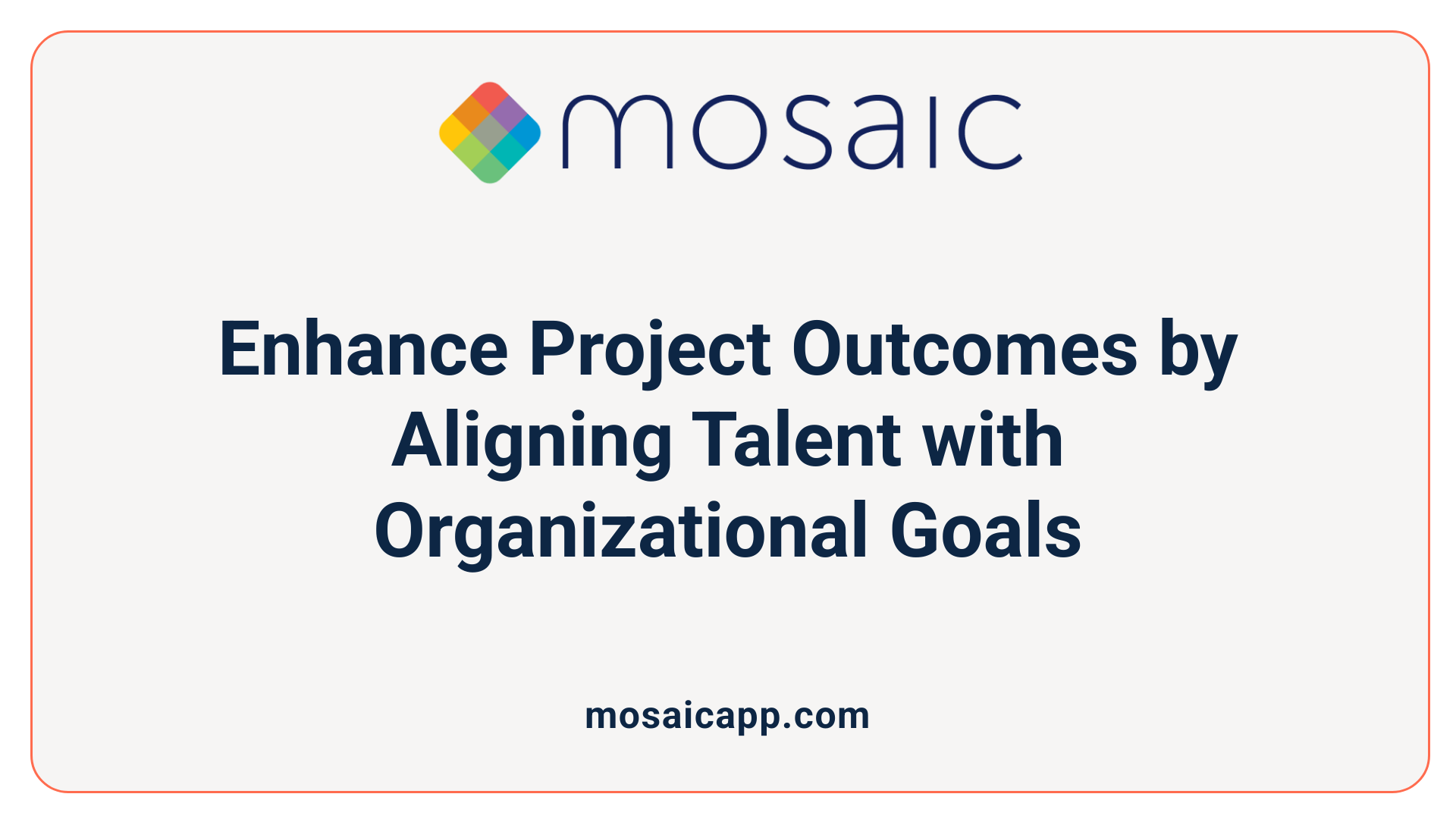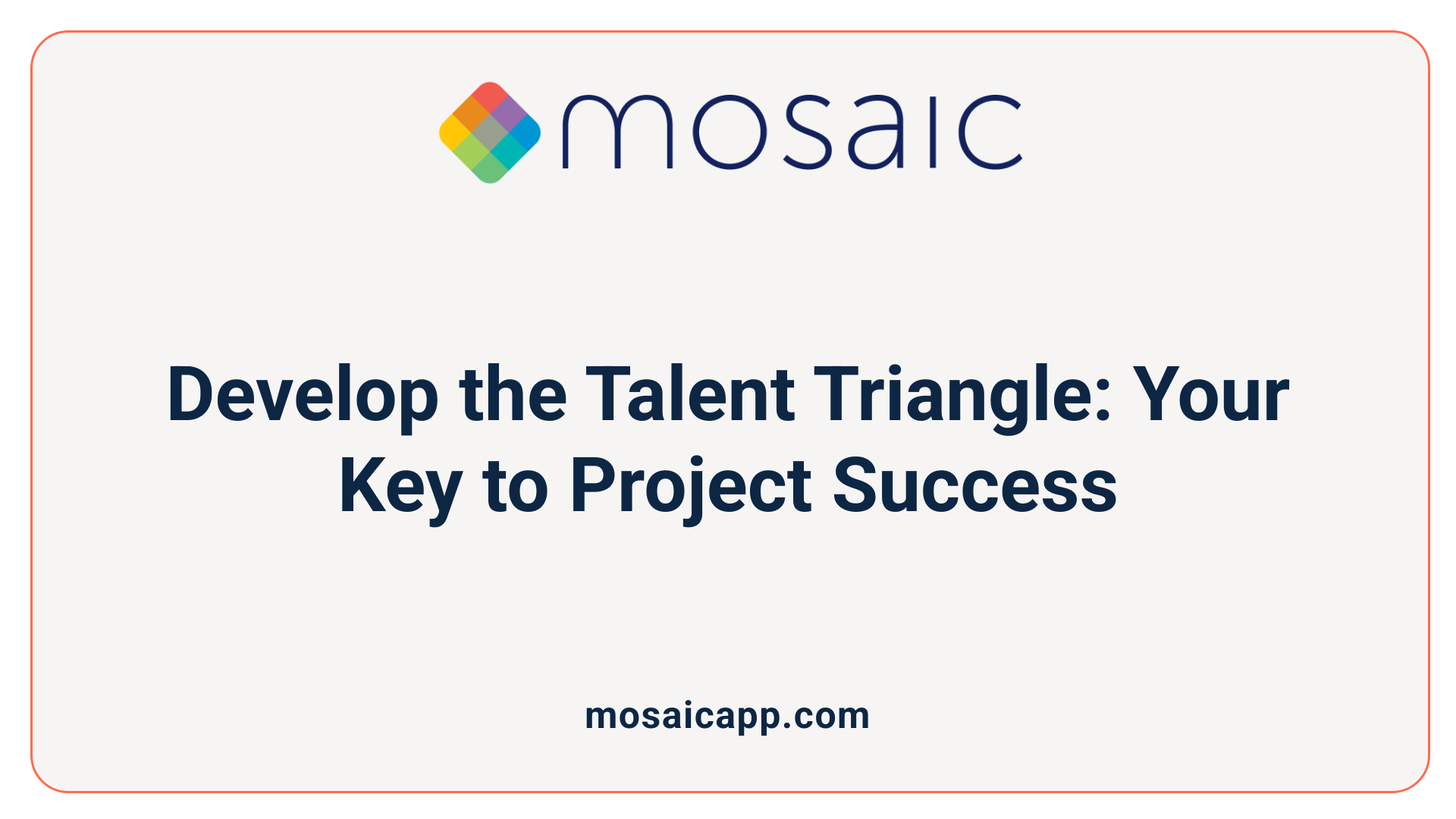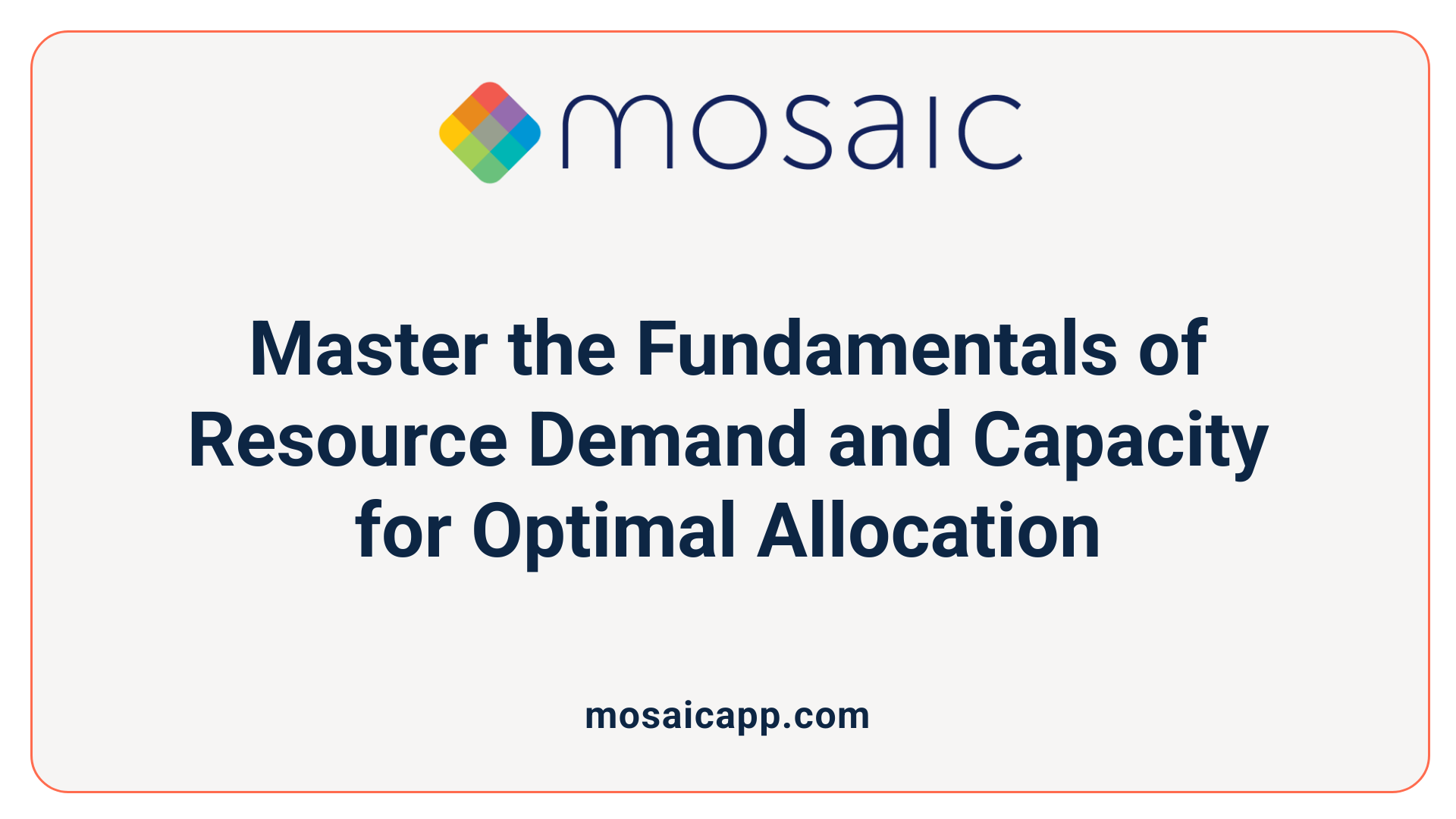Understanding the Critical Link Between Project Demand and Talent Pipelines
In today’s fast-paced business environment, successfully connecting project demand with the right talent is crucial for organizational growth and project success. This article explores how effective resource planning, strategic talent management, and advanced forecasting can enhance project outcomes by aligning talent pipelines with project requirements.
The Impact of Aligning Talent Management with Organizational Strategy

What Are the Benefits of Aligning Talent Management with Organizational Strategy?
Aligning talent management with organizational strategy ensures that the right people are working on the right projects, which enhances overall effectiveness. Organizations that excel at this alignment tend to experience less project waste and better resource utilization, leading to greater operational efficiency.
How Does Alignment Improve Project Success Rates?
Studies show that effective alignment of talent management and organizational strategy increases project success rates significantly, from 58% up to 72%. This improvement stems from better matching of talents with project needs, fostering a workforce skilled in the essential 'talent triangle'—technical expertise, leadership, and strategic business management.
What About Reduction in Project Waste?
Organizations adept at aligning talent management with their strategy reduce project waste by approximately 50%. This reduction arises from more precise resource planning, better forecasting of project demands, and focusing development efforts on skill gaps that directly impact project outcomes.
By focusing on strategic talent development linked directly to project portfolios, companies can optimize project execution, enhance employee engagement, and maximize return on project investments.
The Talent Triangle: Essential Skills for Modern Project Management

What is the Talent Triangle?
The talent triangle is a concept that highlights the three critical skill areas a modern project manager must possess to succeed. It combines technical expertise, leadership skills, and strategic/business management capabilities. This blend ensures that project managers are not only proficient in managing tasks but also adept at leading teams and aligning projects with organizational goals.
Technical Expertise
Technical expertise involves the practical know-how required to manage projects effectively. This includes understanding project management methodologies, tools, and techniques necessary for planning, executing, and monitoring projects. Skills such as scheduling, cost estimating, and risk management fall under this category, enabling project managers to deliver projects on time and within budget.
Leadership Skills
Leadership skills focus on guiding and motivating project teams toward achieving project objectives. This includes communication, conflict resolution, team building, and emotional intelligence. Strong leadership fosters collaboration, resolves conflicts efficiently, and helps maintain high team morale, all of which are essential for project success.
Strategic and Business Management Skills
This area emphasizes the ability to align projects with the broader business strategy. Project managers with strategic and business acumen understand market dynamics, business priorities, and financial impacts. They can make decisions that support long-term organizational goals, ensuring projects contribute to the company’s success beyond immediate deliverables.
Together, these three skill sets form the foundation of effective project management and are crucial for improving project success rates, minimizing waste, and driving strategic outcomes.
Challenges of Filling Project Management Roles and Strategic Talent Development
Why is it difficult to find qualified project management candidates?
Finding qualified candidates for project management roles is a widespread challenge. About 80% of organizations report struggles in sourcing talent with the right combination of skills, which now includes not only technical expertise but also leadership and strategic business management—a blend known as the 'talent triangle'. This multifaceted skill set makes recruitment more complex and heightens competition for capable professionals.
How does strategic talent development improve project outcomes?
Investing in strategic talent development is crucial for organizations aiming to enhance their project success rates. Firms that align talent management closely with their organizational strategy see their project success rates rise significantly, from 58% to 72%. By focusing on nurturing and developing skills aligned with project demands, companies reduce resource waste by up to 50% and achieve better alignment between talent and strategic goals.
What is the impact of investing in talent on organizational strategy?
Organizations that dedicate resources to strategic talent development and align this investment with their project portfolios achieve improved strategic outcomes. Such investments help build a resilient workforce capable of adapting to evolving project requirements, ensure better resource allocation, and enhance overall project execution. In the long term, this leads to higher project delivery success, reduced costs, and supports sustainable growth.
Integrating Pipeline and Resource Management for Accurate Planning
Why Is It Important to Include the Pipeline in Resource Planning?
Including the project pipeline in resource planning is crucial because projects continuously start and finish, requiring a forward-looking approach to resource allocation. Without this, organizations cannot anticipate future staffing needs, leading to mismatches between available talent and project demands. This foresight helps prevent resource shortages and enables smooth transitions between projects.
What Are the Risks of Misaligned Resource Planning?
Mismanaged resource planning that excludes the pipeline can cause serious issues like overcommitment, where staff are stretched too thin, or under-utilization, where resources remain idle. Both scenarios result in wasted money and reduced project success rates. Organizations that do not align talent management with their project pipeline often experience lower project success rates and higher project waste.
How Can Probabilistic Estimates and Real-Time Data Improve Planning?
Effective planning integrates probabilistic estimates of project success, up-to-date start dates, detailed job costing, and real-time data. This approach allows organizations to better predict the likelihood and timing of project demands, ensuring resources are allocated efficiently. It also supports adjustments as conditions change, helping avoid bottlenecks and burnout among teams.
Which Tools Help Consolidate Pipeline and Resource Management?
Modern platforms, such as CMap, offer consolidated systems that unify pipeline and resource management. Features like the Staffing Prediction Report provide insights into capacity versus demand, enabling holistic and accurate planning. Additionally, software tools including Microsoft Project and Planner offer real-time visibility into resource availability and skills, supporting dynamic allocation.
| Aspect | Benefit | Example Tool / Method |
|---|---|---|
| Pipeline Inclusion | Anticipate future demand | Forecasting models with probabilistic data |
| Risk Mitigation | Avoid over- or under-utilization | Real-time monitoring dashboards |
| Data Integration | Gain accurate, up-to-date insights | Job costing and project scheduling software |
| Tool Consolidation | Streamline planning process | CMap, Microsoft Project, Planner |
Integrating pipeline insights directly into resource management leads to improved project predictability, cost savings, and a balanced workload that supports higher success rates across the project portfolio.
Resource Demand and Capacity Planning: Foundations for Effective Allocation

What is the difference between resource demand and resource capacity?
Resource demand refers to the number and types of people with the required skill sets, as well as equipment and materials, needed to complete project tasks—such as designing, coding, testing, and marketing for a mobile app launch. This demand reflects the total workload necessary to meet project goals.
In contrast, resource capacity is about how much time current resources can realistically dedicate without becoming overcommitted. It factors in limitations like sick leave, paid time off, and overall productivity within a given time frame. Capacity measures whether the organization's existing resources can meet the forecasted demand.
How do organizations forecast resource demand?
Forecasting resource demand involves a multi-step process:
- Identifying tasks: Break down the project into specific activities.
- Estimating durations: Assess how long each task will take.
- Calculating demand: Determine the number of resources needed for each task.
- Adding buffer: Include contingency allowances for unexpected changes.
- Setting placeholders: Mark resource needs in planning tools to manage scheduling.
Utilizing resource management software enhances this forecasting by supporting scenario planning, providing utilization dashboards, and automatically flagging bottlenecks. Involving the team and documenting assumptions ensures more accurate and transparent planning.
What is the role of Resource Capacity Planning (RCP)?
Resource Capacity Planning translates a company's strategic vision into operational execution. In environments where talent shortages, tight deadlines, and complex projects pose challenges, RCP balances resource availability against forecasted project demands to prevent overallocation and ensure optimal utilization.
Through RCP, organizations can better align their workforce, equipment, and capital with project priorities, thus enhancing predictability and accelerating delivery timelines.
What are the key components and benefits of RCP?
Key components of RCP include:
- Skill inventory: Understanding the capabilities available.
- Resource capacity: Assessing the time and effort resources can allocate.
- Project demand: Forecasting what projects will require.
- Gap analysis: Identifying shortages or surpluses.
- Utilization forecasting: Predicting how resources will be used.
- Scenario modeling: Planning for different contingencies.
Benefits of RCP encompass improved project predictability, optimized resource use, data-driven decision making, cost reductions, and faster delivery. It also facilitates balancing capacity across projects and proactively managing risks.
| Concept | Definition | Importance |
|---|---|---|
| Resource Demand | Number of resources and materials needed for tasks | Ensures projects are staffed appropriately |
| Resource Capacity | Actual availability and productivity of resources | Prevents overcommitment and burnout |
| Forecasting Steps | Task ID, duration estimate, demand calculation, buffer, etc. | Supports accurate planning and adjustments |
| Resource Capacity Plan | Alignment of resources with demand through analysis | Enhances project success and cost efficiency |
Leveraging Technology and Collaborative Processes in Resource Planning
Use of project portfolio management tools
Modern organizations increasingly rely on project portfolio management (PPM) tools such as Microsoft Project and Planner to gain real-time visibility into resource availability and the specific skills each team member possesses. These platforms allow managers to monitor workloads and skill sets dynamically, facilitating improved allocation of personnel to projects.
Real-time visibility into resources and skills
Having real-time data on resources and their competencies enables organizations to swiftly identify gaps and balance workloads. This transparency reduces risks of overcommitment or under-utilization, ensuring that projects progress smoothly without resource bottlenecks or burnout.
Collaborative involvement of project managers, HR, finance, and department heads
Effective resource planning thrives on collaboration among multiple stakeholders. Project managers contribute insights about project timelines and needs, HR brings expertise on talent management and training opportunities, finance oversees budget alignment, and department heads ensure operational capacities align with strategic goals. This teamwork fosters a shared understanding and enhances decision-making for resource allocation.
Role of technology in forecasting and real-time adjustment
Advanced technology solutions support not only planning but continuous adjustment of resource allocation. Tools enable scenario planning, allowing organizations to forecast upcoming project demands and adjust staffing levels accordingly. Automated dashboards provide utilization metrics and highlight potential bottlenecks, which facilitates proactive management and keeps projects on track despite evolving priorities.
Through integrated technology and collaborative processes, resource planning becomes more accurate and responsive, aligning organizational capabilities closely with project demands.
Strategies for Addressing Resource Gaps and Capacity Challenges

How can upskilling and reskilling initiatives help address resource gaps?
Investing in upskilling and reskilling initiatives is essential to maintaining a resilient workforce. These initiatives equip employees with the latest technical expertise, leadership, and strategic skills needed to meet evolving project demands. By nurturing internal talent, organizations reduce hiring costs and minimize onboarding time, since employees are already familiar with company culture and processes. Additionally, continuous skills development promotes employee engagement and retention, which is crucial for long-term project success and resource planning.
What role do outsourcing and temporary hiring play in managing capacity?
Outsourcing and hiring temporary talent allow organizations to meet short-term or specialized resource needs without committing to permanent hires. This strategy is particularly useful when facing sudden spikes in project demand or skill shortages that internal teams cannot quickly fill. Temporary resources can provide flexibility to handle peak workloads, specialized tasks, and unforeseen project requirements efficiently, helping to prevent burnout and overcommitment.
How can adjusting project timelines and priorities alleviate capacity issues?
Adjusting project timelines and priorities enables organizations to better align resource availability with project demands. By strategically shifting deadlines or reordering project priorities, companies can manage workloads within existing capacity limits, avoiding the need for immediate hiring or overuse of staff. This approach promotes balanced resource utilization and improves on-time delivery without compromising quality.
Why is promoting internal mobility and career path development important?
Encouraging internal mobility and personalized career path development strengthens employee motivation and retention. Employees who see opportunities for growth within the organization are more likely to stay engaged and perform effectively. Internal mobility also ensures that the organization's talent pipeline remains robust by aligning employee skills and aspirations with project needs. This strategy complements other resource planning efforts by maximizing the potential of existing staff and supporting seamless transitions into new roles.
Maintaining a Future-Ready Talent Pipeline through Continuous Monitoring and Adaptation

Why Is Continuous Pipeline Reevaluation Important?
Regularly monitoring and refreshing the talent pipeline is essential for organizations aiming to stay agile in a dynamic project environment. Without continuous reevaluation, companies risk misalignment between available skills and upcoming project demands, leading to resource shortfalls or costly delays. Keeping the pipeline under review helps identify emerging skill gaps early and allows for timely upskilling, reskilling, or strategic hiring.
How Does Aligning the Talent Pipeline with Strategic Business Goals Benefit Organizations?
Aligning talent management with organizational strategy improves project success rates—from 58% to 72%—and reduces wasted resources by up to 50%. When the talent pipeline reflects strategic priorities and upcoming project portfolios, organizations gain greater predictability and resource utilization. This alignment also fosters better employee engagement through personalized career paths, encouraging retention and internal mobility.
What Are the Key Performance Indicators in Capacity Planning?
Critical KPIs for effective capacity planning include:
| KPI | Description | Why It Matters |
|---|---|---|
| Resource Utilization Rate | Percentage of staff time effectively assigned | Indicates efficiency and workload balance |
| Forecasting Accuracy | Precision of resource demand predictions | Improves planning and reduces bottlenecks |
| Resource Alignment Score | Degree to which talent matches project needs | Reflects strategic fit and readiness |
| Bench Time | Time staff spend unassigned | Impacts cost control and talent engagement |
| Burnout and Attrition Rates | Indicators of workforce stress and turnover | Helps maintain sustainable workforce health |
Tracking these KPIs supports proactive adjustments and strategic decision-making.
How Do Industry-Specific Considerations Affect Talent Pipeline Management?
Different sectors face unique capacity planning challenges requiring tailored approaches. For example, healthcare must account for certification renewals and shift patterns, while marketing emphasizes creative skill cycles. Professional services and accounting often deal with fluctuating client demands. Successful pipeline management incorporates these nuances through specialized software and flexible strategies to maintain future readiness.
Maintaining a future-ready talent pipeline demands ongoing attention, strategic alignment, and measured use of KPIs. Organizations that practice continuous adaptation improve project outcomes, optimize resource costs, and build resilient workforces.
Achieving Seamless Alignment of Project Demand and Talent Supply
Effectively linking project demand with talent pipelines is a multifaceted challenge that requires strategic foresight, collaborative planning, and the adoption of advanced tools and methodologies. Organizations that prioritize integrating their talent management with project and resource planning not only enhance their project success rates but also reduce waste, optimize capacity utilization, and foster workforce resilience. Continuous adaptation and monitoring ensure that talent pipelines remain aligned with evolving project portfolios, positioning organizations for sustained operational excellence and competitive advantage.
References
- Linking project talent and strategy
- CMap | How to combine your pipeline and resourcing
- Creating a Resource Demand and Capacity Management ...
- How To Do Resource Demand Planning: 5 Key Steps
- A Complete Guide to Resource Capacity Planning
- 7 Tips for Choosing Projects and Managing Your ...
- Talent Pipeline Management: A Sustainable Talent Strategy


